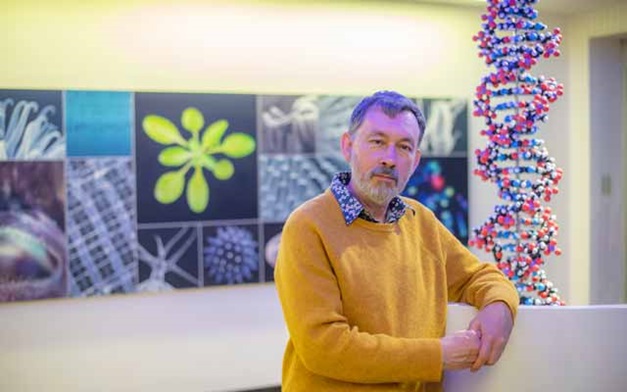Male DNA cracks crime and illuminates history
DNA profiling is not the one-size-fits-all forensic tool we imagine it to be. When forensic scientists can extract a good sample from a crime scene, it works fine: a DNA profile from autosomal DNA (DNA from the highly variable non-sex chromosomes) uniquely identifies the people who were there.
But real life is messier. DNA samples can be tiny or, in rape and assault cases, mixed – with the female component vastly outweighing the male. That’s when forensic scientists need other tools to help them identify the male component of a sample.
Finding variation in DNA that changes slowly
The DNA in the male Y-chromosome (Y-DNA) doesn’t seem like fertile ground for forensics. Y-DNA doesn’t go through the reproductive reshuffling that makes every person’s autosomal DNA unique. Y-DNA instead passes down from father to son unchanged, apart from the occasional random mutation.
Nevertheless, the potential of Y-DNA has never been lost on Professor Mark Jobling. When he did his PhD at the University of Oxford, he was one of a handful of Y-DNA researchers around the world.
“Shortly afterwards, I came to the University of Leicester to give a talk about my findings,” he says. “That’s where I met Professor Alec Jeffreys. He encouraged me to apply for a fellowship here. Since then, I’ve devoted my career to the study of Y-DNA.”
Working with others, Professor Jobling has revealed the characteristics of Y-DNA, and helped lay the groundwork for its use in forensics. His Y-chromosome research has uncovered many of the vital identifying strings known as short tandem repeats (STRs) that do exhibit variability. An STR is a string of DNA containing a short sequence repeated multiple times. Since the string has no function, a mutation – 14 repeats instead of 13, for example – has no physiological effect.

Y-DNA is not so good at identifying individuals, but it is extremely powerful for exonerations. Y-DNA is slow to change, so it has a high degree of geographical differentiation. It tells us where in the world a man’s ancestors come from, and who his male relatives are. That might be all we need. Even if a mixed male-female sample contains 10,000 times more female DNA than male DNA, we can still get a useful profile.
Self-swabbing for offender DNA
In an ideal world, every victim of sexual assault would have ready access to professionals who can take samples for forensic analysis. In developing nations or during humanitarian crises this may not be possible, so the next best thing would be self-swabbing. Working with Professor Lisa Smith of the University of Leicester’s Criminology Department, Professor Jobling has developed a self-administered intimate swab that gathers DNA for Y-STR and autosomal profiling.
“We’re currently trialling the swabs in Kenya. There’s some distrust, and fear of entrapment, but this could not apply to attacks by strangers, and rapes where the victim is below the age of consent. The technology works, but society and the legal system are slow to adapt. We’re working with NGOs who do the advocacy.”
History is written in our DNA
“One of the things I’ve wanted to do with DNA is illuminate human history,” says Professor Jobling. “DNA that evolves slowly is great for tracing lineages from the Bronze Age to the present day. The progress of mass movements such as European colonisation are traceable through DNA. By studying the distribution of Y-DNA and mitochondrial DNA – the DNA passed down through females – we can also see that males and females have behaved differently over the generations. The long-term pattern is for males to stay closer to their birthplaces on marriage, and females to move. But in the European colonisations of the last 500 years, it was the males who moved and spread their Y-DNA.”
An intriguing aspect of the persistence of Y-DNA is that there should be a correlation between family names and Y-DNA because both are passed down from father to son. Professor Jobling’s team were the first to suggest this in 1995.
“When I give public talks, the one thing everyone asks about is Y-DNA and surnames. Often there isn’t much of a link because family names – Smith for example – originate many times over. But for rarer family names – less than a few thousand individuals – the correlation can be good. When we analysed the name Attenborough, we found that 90% had the same Y-chromosomes. The link suggests a forensic application: given a sample of Y-DNA, we might be able to predict a surname.”
Taking the broader view
Professor Jobling’s research work has been on fundamental questions about genetic diversity and mutation, but also with an emphasis on translational research – science that leads to practical outcomes.
“I was never in the gene-hunter camp so there’s not been a eureka moment. I’ve always been interested in broader questions and in collaborating with others. Their work feeds into my own interests: forensics, genealogy, understanding history and the different roles that males and females have played in human history.
“I’m looking forward to what the next generation will do. Our research interests here at Leicester are moving on to animal genetics and conservation. In contrast, most aspects of the human genome have been nailed pretty firmly. Interest in ancient DNA is likely to continue, but researchers will eventually come up against a brick wall. There’s a limit on how far back we can go back for usable DNA. But who knows? Twenty years ago no one imagined being able to analyse Neanderthal DNA; now we have dozens of Neanderthal genome sequences.”
This open-ended attitude to what’s possible has fuelled Professor Jobling’s research. It’s touched our lives in numerous ways: more convictions or exonerations in the courts, valuable data for commercial organisations to develop forensic kits, a window into family lineages and a richer understanding of ancient and social history.





